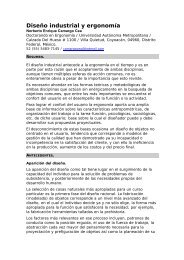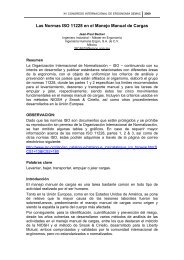ERGONOMÍA OCUPACIONAL - SOCIEDAD DE ERGONOMISTAS ...
ERGONOMÍA OCUPACIONAL - SOCIEDAD DE ERGONOMISTAS ...
ERGONOMÍA OCUPACIONAL - SOCIEDAD DE ERGONOMISTAS ...
You also want an ePaper? Increase the reach of your titles
YUMPU automatically turns print PDFs into web optimized ePapers that Google loves.
Ergonomía Ocupacional. Investigaciones y Aplicaciones. Vol 3 2010<br />
The first stage of the process is the initial contact with the client. The assessment sequence<br />
is generally triggered an employee or other individual (e.g. health services, management)<br />
requesting an evaluation of the workstation in response to a perceived issue such as discomfort or<br />
pain (reactive).<br />
The next stage includes obtaining background information, workstation and anthropometric<br />
measurements (as shown in a pictorial diagram that is provided), body part discomfort rating, and<br />
digital data from the client. The still photos and /or video clips of the work area and the activities<br />
being performed is the additional piece of data that is critical to the successful completion of a<br />
remote ergonomics evaluation. The still images should be of the client in their work environment<br />
simulating work tasks from different angles and locations to adequately demonstrate the postures<br />
obtained during work. When possible, video footage should also be obtained of the real-time<br />
performance of work (or simulated work) to demonstrate frequency information. A good rule of<br />
thumb is that video data should be 5-10 minutes in length and include all significant tasks<br />
performed by the client.<br />
During the time the ergonomist reviews the data provided by the client, there might be a need<br />
to contact the client to clarify or obtain more information about the discomfort, tasks, or<br />
workstation setup. During the evaluation, at least three opportunities for information exchange via<br />
phone call or video conference should be provided. The initial interaction should be to clarify the<br />
initial background information provided and educate the client on proper ergonomic setup. The<br />
second interaction should be to review the work related risk factors identified through the<br />
evaluation. At this time, the ergonomist will review the recommendations and discuss possible<br />
options for modification to a setup. The third interaction should occur after the workstation<br />
modifications have been made by the client. This interaction may be visual (e.g. include photos or<br />
video) in addition to verbal. This final stage of the evaluation is a very important element of the<br />
process. A follow-up is essential to ensure that the end-user neither experiences any discomforts<br />
similar to the ones before the workstation modification nor does he/she develop any additional<br />
discomforts. At this time, the virtual ergonomist reviews the worksite for completeness of the<br />
recommendations and to ensure that no other risk factors are present. Additional follows may be<br />
scheduled as per need.<br />
Sociedad de Ergonomistas de México, A.C. 153




